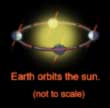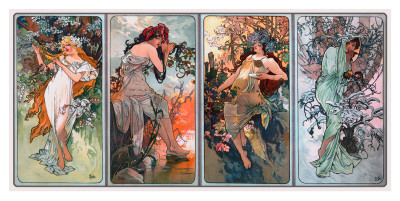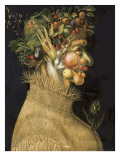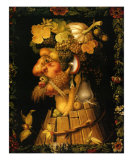|
|
The Seasons
for the classroom, home schoolers, and theme decor for offices.
|
social studies > holidays & observances posters > SEASONS > Autumn > Winter > Spring > Summer • animated .gif of seasonal changes.
|
|
 Seasons are the periodic divisions of the year experienced as changes of weather. Because the Earth has a 23.5° axis tilt to the orbit plane, the northern and southern hemispheres alternate in distance from the sun. This difference in exposure is enough to make a major change in daylight hours and conditions for plant growth. Seasons are the periodic divisions of the year experienced as changes of weather. Because the Earth has a 23.5° axis tilt to the orbit plane, the northern and southern hemispheres alternate in distance from the sun. This difference in exposure is enough to make a major change in daylight hours and conditions for plant growth.
In Greek mythology the seasons are explained as the alternating joy and mourning of Demeter (Roman goddess Ceres), the goddess of agriculture, to the return and banishment of her daughter Persephone, to the underground.
Equinoxes and solstices mark relative positions of the orbiting Earth to the sun. Equinox is related to the word equal and means the sun is observed directly above the equator and experienced as 12 hours of sunlight and 12 hours of darkness. Equinoxes occur twice a year - around March 20 and September 23, and observed as the first days of Spring and Autumn respectively, in the Northern Hemisphere. Solstice (sol + stitium= stoppage), is when the sun is furthest from the celestial equator and experienced as either the shortest (Winter) or longest (Summer) day of the year, depending on hemisphere. Stonehenge is an example of an ancient astronomical observatory, where the people could predict be assured that the sun was following its usual path.
The “tropics”, the region circling the planet Earth at the equator and limited by the the lines of latitude called the Tropic of Cancer (23°27'N) and the Tropic of Capricorn (23°27'S), experience the seasons as dry or rainy. The temperate zones, global climate bands that lie between the tropic latitudes and the polar circles (66˚33' 38"N/S), experience gradual extremes. Seasons around the North and South Poles are noted annually by at least one 24 hour period of constant daylight or darkness. <geography posters>
|
|
|
|
previous page | top
|
|
I have searched the web for visual, text, and manipulative curriculum support materials - teaching posters, art prints, maps, charts, calendars, books and educational toys featuring famous people, places and events - to help teachers optimize their valuable time and budget.
Browsing the subject areas at NetPosterWorks.com is a learning experience where educators can plan context rich environments while comparing prices, special discounts, framing options and shipping from educational resources.
Thank you for starting your search for inspirational, motivational, and educational posters and learning materials at NetPosterWorks.com. If you need help please contact us.
|
|
|
|




 Seasons are the periodic divisions of the year experienced as changes of weather. Because the
Seasons are the periodic divisions of the year experienced as changes of weather. Because the 







